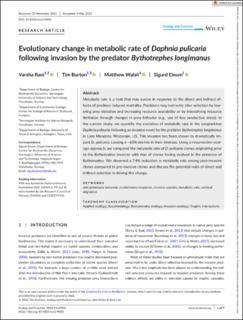| dc.contributor.author | Rani, Varsha | |
| dc.contributor.author | Burton, Tim | |
| dc.contributor.author | Walsh, Matthew | |
| dc.contributor.author | Einum, Sigurd | |
| dc.coverage.spatial | Wisconsin, USA | en_US |
| dc.date.accessioned | 2023-02-01T12:34:51Z | |
| dc.date.available | 2023-02-01T12:34:51Z | |
| dc.date.created | 2022-09-19T08:21:56Z | |
| dc.date.issued | 2022 | |
| dc.identifier.citation | Ecology and Evolution. 2022, 12 (6), . | en_US |
| dc.identifier.issn | 2045-7758 | |
| dc.identifier.uri | https://hdl.handle.net/11250/3047720 | |
| dc.description.abstract | Metabolic rate is a trait that may evolve in response to the direct and indirect effects of predator-induced mortality. Predators may indirectly alter selection by lowering prey densities and increasing resource availability or by intensifying resource limitation through changes in prey behavior (e.g., use of less productive areas). In the current study, we quantify the evolution of metabolic rate in the zooplankton Daphnia pulicaria following an invasive event by the predator Bythotrephes longimanus in Lake Mendota, Wisconsin, US. This invasion has been shown to dramatically impact D. pulicaria, causing a ~60% decline in their biomass. Using a resurrection ecology approach, we compared the metabolic rate of D. pulicaria clones originating prior to the Bythotrephes invasion with that of clones having evolved in the presence of Bythotrephes. We observed a 7.4% reduction in metabolic rate among post-invasive clones compared to pre-invasive clones and discuss the potential roles of direct and indirect selection in driving this change | en_US |
| dc.language.iso | eng | en_US |
| dc.rights | Navngivelse 4.0 Internasjonal | * |
| dc.rights.uri | http://creativecommons.org/licenses/by/4.0/deed.no | * |
| dc.subject | anti-predatory behavior | en_US |
| dc.subject | evolutionary response | en_US |
| dc.subject | invasive species | en_US |
| dc.subject | metabolic rate | en_US |
| dc.subject | vertical migration | en_US |
| dc.title | Evolutionary change in metabolic rate of Daphnia pulicaria following invasion by the predator Bythotrephes longimanus | en_US |
| dc.title.alternative | Evolutionary change in metabolic rate of Daphnia pulicaria following invasion by the predator Bythotrephes longimanus | en_US |
| dc.type | Peer reviewed | en_US |
| dc.type | Journal article | en_US |
| dc.description.version | publishedVersion | en_US |
| dc.rights.holder | © 2022 The Authors | en_US |
| dc.subject.nsi | VDP::Matematikk og Naturvitenskap: 400::Zoologiske og botaniske fag: 480::Økologi: 488 | en_US |
| dc.source.pagenumber | 0 | en_US |
| dc.source.volume | 12 | en_US |
| dc.source.journal | Ecology and Evolution | en_US |
| dc.source.issue | 6 | en_US |
| dc.identifier.doi | 10.1002/ece3.9003 | |
| dc.identifier.cristin | 2052882 | |
| dc.relation.project | Norges forskningsråd: 223257 | en_US |
| cristin.ispublished | true | |
| cristin.fulltext | original | |
| cristin.qualitycode | 1 | |

